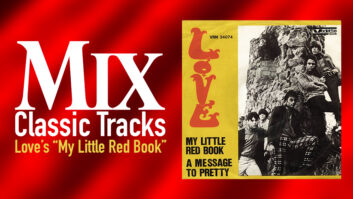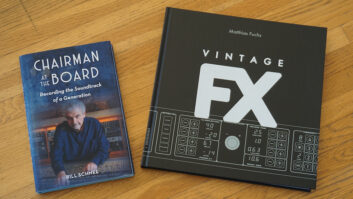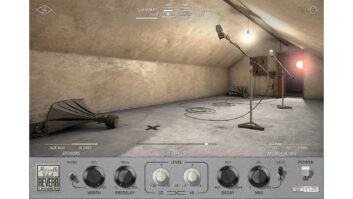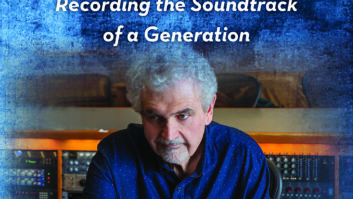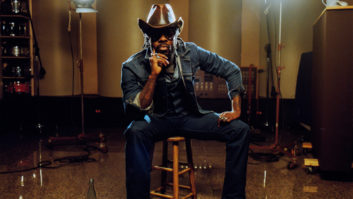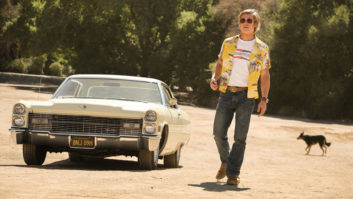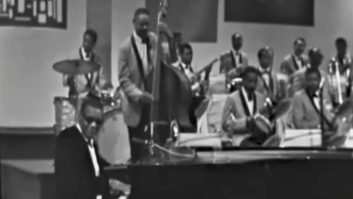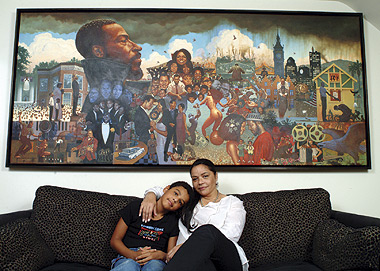
Janis Gaye, with her and Marvin Gaye’s grandson, Nolan, in front of the Kadir Nelson mural.
Photo: Jason Vaughn
Marvin Gaye loved being in the studio. He loved to write, play, orchestrate, sing, record, direct, produce, jam, party and sometimes just hang with musicians and friends. At various times in his career, it was a place of business; at other times a place of pleasure. For a few years, the studio was even his home. When it became apparent that his well-documented differences with Motown could not be repaired, one of his first orders of business was to build a private facility, the restored and re-invented version of which appears on this month’s cover.
In the mid-’70s, Marvin Gaye’s studio was the place to be in Los Angeles, the Studio 54 of the West Coast. If you got past the gate, one engineer recalls, you just knew you had entered someplace magical. And you knew you had arrived. Yes, the parties were legendary, at times running 24/7. Muhammad Ali would stop by. Diana Ross, too. Rock stars and beautiful women. Film stars and politicians. Everybody wanted in. But while the parties drew the crowds, it was the core cast of musicians that provided the soul. Musicians were always around, writing, playing, hanging out. They helped to create the sound of Gaye’s evolving amalgam of jazz, R&B and soul. Gaye lived there for long stretches at a time, always making music.
Then in the late ’70s, it all came crashing down, and Marvin lost the studio amid his mounting financial and legal problems. “He went into a deep depression,” recalls his former wife, Janis Gaye, mother to his children Nona and Frankie. “The enormity of losing his studio was so devastating to him that he was never the same after that. We had gone bankrupt, lost our home, our cars — everything. But he was a broken man over the studio, and not just for the musical creativity, but for what he had done architecturally. It was very emotional for him, and for everybody around him.”
The studio languished for a while before being rechristened Eldorado Studios in the late ’80s and hosting a few hits, including Alice in Chains’ Dirt. Then in 1997, guitarist/producer/former major-label exec John McClain stepped in and rescued the space from being turned into a digital photo lab.
“When I think of historic studios, this is it for me,” McClain says. “Ray Charles, Jimi, Elvis, they all had a space, and here, Marvin just nailed it. He made it big so he could do strings and horns. He could do anything he wanted. I didn’t know Jan [Gaye] then. I simply wanted to make it a Mecca for the Gaye family.”
The reclusive and humble McClain downplays his role in the resurrection of the studio and the restoration of Gaye’s name, saying he is simply the “curator” and wanted to treat the Gaye family right and have a place to hang out with his boys. To Jan Gaye, however, he has been a prince.
“At first I was really angry because they were using Marvin’s name,” Jan Gaye recalls. “Who is using Marvin’s name? Nobody called. But then Nona [Gaye] got flowers on her birthday from this John McClain guy, celebrating her album, and we thought, ‘Who is this guy being so kind when no one else is?’ I’m wary of people and didn’t know what to expect. Then when I walked through those doors, all the negatives fell away. I saw the marble etching on the threshhold, then I came down the stairs and turned to the mural and just stopped in my tracks. I stared and cried and stared and cried. I knew then that he was all about Marvin.”
Today, Marvin’s Room is one of the most well-appointed and musician-friendly studios, a playground for those who seek the blend of vintage sound and modern production. Michael Jackson christened the studio in 1999 with his most recent album. Since then, engineer John Nettlesby and crew have hosted the likes of Usher, Mariah Carey, Yolanda Adams, Lenny Kravitz, Mary J. Blige, The Game and Luther Vandross in some of his final sessions before he passed.
There’s an 80-input SSL 9000 J; 32 channels of Pro Tools HD; 5.1 monitoring; Pultecs, Fairchilds, GML processing; along with everything else you could think of vintage and modern. In the studio are dozens of amps, keyboards, rhythm boxes and a wealth of music-making devices, all in perfect shape. There’s a Hammond B3 and two Mellotrons. Prince’s board sits upstairs waiting for a room. A 9-foot Hamburg Steinway sits in the center. As a bonus, the spirit and vibe of Gaye permeates the place, to the point that nearly every artist who has worked there has come out of the studio saying, “I felt Marvin with me on that track.” In that sense, the studio has become a living legacy.
“This was always like a second home for Marvin, me and the kids,” Jan Gaye says. “He fancied himself an architect, an antiques dealer, and he oversaw everything, from the colors to where the seats would go. This place became alive. It was a part of him.”
The studio is merely the first part of the restoration of Gaye’s story. An A-list film project is in the works, and Janis Gaye’s story will be coming out in a book written by Regina Jones, co-founder of Soul magazine. Plus, there are some merchandising deals on the way with Michael Bolton’s company. Finally, the world will see the genius of Marvin Gaye in all forms.
Tom Kenny is Mix’s editorial director.

